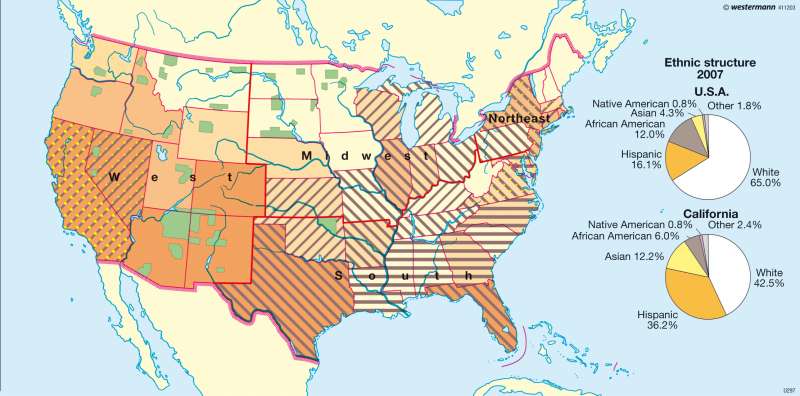Ethnic structure
U.S.A. - Past and present
978-3-14-100790-9 | Page 136 | Ill. 3

Information
Today, the United States has approximately 300 million residents. Almost two thirds are whites, as descendants of immigrant settlers from Europe. African-Americans, descendants of African slaves, represent approximately 12 percent of the population. Around 16 percent are Latin America Hispanics with about 4 percent from Asia. The descendants of the Native Indians represent less than 1 percent of the population.Regional distribution
The percentage of African-Americans is high, especially in the south-eastern regions, with a clear emphasis in the former Confederate states such as Mississippi, Georgia and South Carolina. Until 1950, some two thirds of all blacks lived in the south. Since then, their numbers in other parts of the country has steadily increased.
The Spanish-speaking Hispanics live mostly in the southern states of the America, particularly those bordering Mexico:Texas, New Mexico, Arizona and California. It is only in New York, New Jersey and Florida that the larger Hispanic populations are not found. Their share of the total population has increased for several years — both through legal and illegal immigration. Therefore, a recurring theme in U.S. policy is the border with Mexico.
Distributed over a widespread area, throughout North America, is the rather small minority of people of Asian origin. In the states of California, Washington, New York and New Jersey they represent larger proportions of the population. The influx of Asian immigrants began mainly after the World War Two.
The proportion of Indians has increased significantly in recent decades. Most tribes have largely lost their original ethnic culture, but were able in the end, to stabilise the population in the reserves. In 1960, approximately 500,000 Indians lived in North America. By 1980, it was at almost 1.5 million.
Settlement History
Even today, the American settlement history determines the ethnic division of the country. Nearly all of today's Indian reservations are located in states that had acceded to the Union relatively late. Aside from Alaska, where the indigenous peoples are by far the most represented by over 15 percent of the total population, larger Indian populations are only found in New Mexico, South Dakota, Montana and Arizona. With the original settlement of Europeans on the east coast, the Indian population has almost completely disappeared there.
In the northern founding states, in which slavery was of no great importance, the descendants of European settlers represent strong majorities, such as in Vermont, Maine and New Hampshire. Large African-American minorities are found especially in the south, while their porportion of the total population in the northern states of the Midwest is negligible.
K. Lückemeier, H. D. Laux, G. Thieme; Ü: C. Fleming




